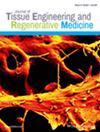Combining Piezoelectric Stimulation and Extracellular Vesicles for Cartilage Regeneration
IF 3.1
3区 生物学
Q2 BIOTECHNOLOGY & APPLIED MICROBIOLOGY
Journal of Tissue Engineering and Regenerative Medicine
Pub Date : 2023-06-29
DOI:10.1155/2023/5539194
引用次数: 0
Abstract
Numerous patients experience articular cartilage defects (ACDs), which are characterized by progressive cartilage degradation and often lead to osteoarthritis (OA). Consequently, 44.7% of OA patients suffer from dyskinesia or disability. Current clinical drug treatments offer limited effectiveness in fully curing the disease. In this study, we propose a collaborative approach that combines physical and biological cues to promote cartilage regeneration. A biodegradable piezoelectric poly (l-lactic acid) (PLLA) nanofiber scaffold facilitates in situ, battery-free electrical stimulation under natural joint loading, while extracellular vesicles (EVs) serve as communication mediators between cells and promote cell proliferation, migration, and secretion of type II collagen. In this combined approach, EVs attached to PLLA are gradually released by localized piezoelectric electrical stimulation and taken up by chondrocytes. This process results in the organization of type II collagen along the PLLA fiber surface, ultimately forming cartilage lacunae that facilitate the residence of new chondrocytes. As an outcome, a significant round cartilage defect (diameter: 3 mm and depth: 1 mm) in the PLLA/EVs group (rat and knee) was rapidly restored within six weeks. In contrast, individual EVs and PLLA groups demonstrated considerably weaker cartilage regeneration capabilities. This research suggests that the synergistic effect of electromechanical stimulation and EVs-based biological cues is a crucial intervention method for treating OA.结合压电刺激和细胞外囊泡的软骨再生
许多患者经历关节软骨缺损(ACDs),其特征是软骨进行性降解,并经常导致骨关节炎(OA)。因此,44.7%的OA患者患有运动障碍或残疾。目前的临床药物治疗在完全治愈这种疾病方面效果有限。在这项研究中,我们提出了一种结合物理和生物线索来促进软骨再生的合作方法。可生物降解的压电聚乳酸(PLLA)纳米纤维支架在自然关节负载下促进原位、无电池的电刺激,而细胞外小泡(EVs)作为细胞之间的通讯介质,促进细胞增殖、迁移和II型胶原的分泌。在这种联合方法中,附着在PLLA上的EVs通过局部压电刺激逐渐释放,并被软骨细胞吸收。这一过程导致II型胶原沿着PLLA纤维表面组织,最终形成软骨腔隙,促进新软骨细胞的驻留。结果,出现明显的圆形软骨缺损(直径:3 mm和深度:1 mm)在6周内迅速恢复。相反,个别EV和PLLA组的软骨再生能力明显较弱。这项研究表明,机电刺激和基于EVs的生物线索的协同作用是治疗OA的关键干预方法。
本文章由计算机程序翻译,如有差异,请以英文原文为准。
求助全文
约1分钟内获得全文
求助全文
来源期刊
CiteScore
7.50
自引率
3.00%
发文量
97
审稿时长
4-8 weeks
期刊介绍:
Journal of Tissue Engineering and Regenerative Medicine publishes rapidly and rigorously peer-reviewed research papers, reviews, clinical case reports, perspectives, and short communications on topics relevant to the development of therapeutic approaches which combine stem or progenitor cells, biomaterials and scaffolds, growth factors and other bioactive agents, and their respective constructs. All papers should deal with research that has a direct or potential impact on the development of novel clinical approaches for the regeneration or repair of tissues and organs.
The journal is multidisciplinary, covering the combination of the principles of life sciences and engineering in efforts to advance medicine and clinical strategies. The journal focuses on the use of cells, materials, and biochemical/mechanical factors in the development of biological functional substitutes that restore, maintain, or improve tissue or organ function. The journal publishes research on any tissue or organ and covers all key aspects of the field, including the development of new biomaterials and processing of scaffolds; the use of different types of cells (mainly stem and progenitor cells) and their culture in specific bioreactors; studies in relevant animal models; and clinical trials in human patients performed under strict regulatory and ethical frameworks. Manuscripts describing the use of advanced methods for the characterization of engineered tissues are also of special interest to the journal readership.

 求助内容:
求助内容: 应助结果提醒方式:
应助结果提醒方式:


